Taxpayer Alert
TA 2017/1
Re-characterisation of income from trading businesses-
This document has changed over time. View its history.
| Alerts provide a summary of our concerns about new or emerging higher risk tax or superannuation arrangements or issues that we have under risk assessment.
While an Alert describes a type of arrangement, it is not possible to cover every potential variation of the arrangement. The absence of an Alert on an arrangement or a variation of an arrangement does not mean that we accept or endorse the arrangement or variation, or the underlying tax consequences. Refer to PS LA 2008/15 for more about Alerts. See Alerts issued to date. |
Description
We are reviewing arrangements which attempt to fragment integrated trading businesses in order to re-characterise trading income into more favourably taxed passive income. Our concern arises where a single business is divided in a contrived way into separate businesses. The income that might be expected to be subject to company tax is artificially diverted into a trust where, on distribution from the trust, that income is ultimately subject to no tax or a lesser rate than the corporate rate of tax.
These arrangements have the potential to erode the corporate tax base, particularly where they are promoted to overseas investors as a way to acquire tax advantages in Australia.
Stapled structures are one mechanism being used in these arrangements, but our concerns are not limited to arrangements involving stapled structures. For simplicity, when we describe these arrangements:
- •
- Operating Entity is a company or corporate tax entity which carries on a trading business, is subject to tax at the corporate tax rate and claims a deduction in respect of payments it makes to Asset Trust, and
- •
- Asset Trust is purportedly a flow-through trust under Division 6 of Part III of the Income Tax Assessment Act 1936 (ITAA 1936) with the result that, generally, the income received by or through Asset Trust is purportedly subject to a rate of tax much lower than the corporate rate.
Transactions/structures to which this Alert does not apply
This Alert does not extend to an Australian real estate investment trust (A-REIT) which derives all or most of its rental income from unrelated third party tenants and which has not entered into any of the arrangements discussed in this Alert.
This Alert does not extend to privatisations of businesses which are effectively land (and land improvement) based or heavily reliant on particular land holdings and related improvements.
This Alert ceases to apply in relation to cross staple arrangements subject to the operation of the Treasury Laws Amendment (Making Sure Foreign Investors Pay Their Fair Share of Tax and Other Measures) Act 2019 (stapled structures law). The stapled structures law relevantly addresses certain cross staple rental arrangements.
We recognise there are businesses ('third party use of building' businesses) operated through a stapled structure where:
- •
- Asset Trust leases buildings of a traditional real estate nature to Operating Entity
- •
- Operating Entity makes those buildings available for use (typically as a dwelling) by independent end-users, albeit not in the form of a lease (such as a temporary licence to occupy the dwelling), and
- •
- a common observable market or practice already exists in that industry for building owners like Asset Trust to lease those types of buildings to unrelated third parties to carry on the same type of business Operating Entity carries on with the buildings.
We encourage taxpayers considering stapled structures for these types of businesses to engage with us. Generally, where we see such businesses, our concern will focus on the arrangements between entities within the stapled structure (such as ensuring Operating Entity retains a sufficient share of the profits), rather than the stapled structure itself.
What are our concerns?
Stapled structures have been used in the tax system for many years, generally in the commercial property investment sector. In traditional stapled structures, separate businesses that are capable of being operated entirely independently are combined. Cross-staple dealings tend to be immaterial compared to the core business operations of each entity and most significantly, Asset Trust receives all or most of its income, such as rent, from unrelated third party tenants in respect of its discrete passive investment activities. Like any business, these structures have general tax compliance issues to consider but the use of the stapled structure itself is not something we are concerned with.
The structures of concern in this Alert attempt to fragment an integrated trading business in order to re-characterise trading income into more favourably taxed passive income. The re-characterised income is diverted to a flow-through trust with the result that:
- •
- Asset Trust is assessed on a flow-through basis (that is, usually not taxed)
- •
- distributions from Asset Trust may be ultimately subject to taxation at a rate of commonly between 0 to 30%, and
- •
- although Operating Entity would be taxed at the corporate rate of tax, it is unlikely to have significant taxable income, largely because of deductions in respect of the payments to Asset Trust.
But for these structures, it would be reasonable to expect the trading income to form part of the taxable income of a corporately taxed entity.
We are reviewing the effectiveness of these arrangements under the substantive provisions of the income tax legislation, applying to Asset Trust, Operating Entity and investors into these entities. Even if they are effective under the substantive provisions, we are concerned these arrangements are being entered into or carried out for the dominant purpose of obtaining a tax benefit. This might attract the operation of the anti-avoidance rule in Part IVA of the ITAA 1936.
Description
There are four arrangements where we have seen this occur using stapled structures. While stapled structures are one mechanism we see regularly being adopted in these arrangements, our concerns exist even if the entities are not stapled.
1. Finance staple
A finance staple typically displays all or most of the following features:
- •
- Operating Entity carries on a business usually with external debt which would ordinarily require a certain level of equity. However, Operating Entity in fact carries much less than the expected level of equity.
- •
- Asset Trust receives trust equity from the investors as beneficiaries
- •
- Asset Trust's equity is lent to Operating Entity at interest (the cross-staple debt)
- •
- Operating Entity claims a tax deduction for the interest payments made to Asset Trust under the cross-staple debt, and
- •
- the interest is usually distributed to the investors.
The diagram below shows a simplified example of a finance staple.
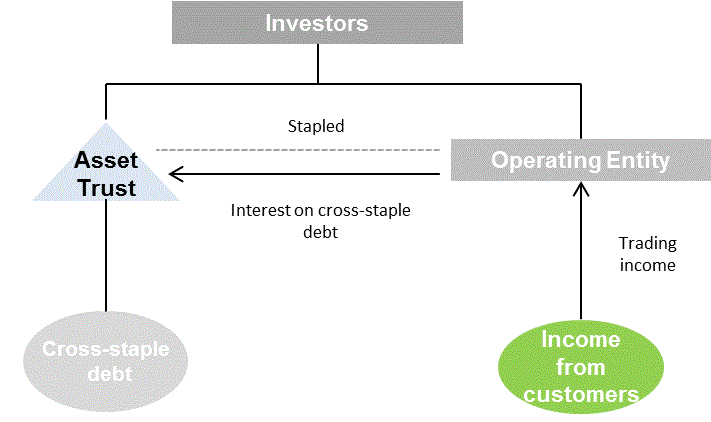
We are concerned:
- •
- section 26-26 of the Income Tax Assessment Act 1997 (ITAA 1997) may deny deductions to Operating Entity (due to the application of sections 974-70 or 974-80), and
- •
- Asset Trust may control, or be able to control, Operating Entity for the purposes of Division 6C of Part III of the ITAA 1936.
An example of this would be where Operating Entity's continuation as a going concern is contingent on Asset Trust deciding not to exercise a right it has to trigger Operating Entity's insolvency.
2. Synthetic equity staple
A synthetic equity staple typically displays all or most of the following features:
- •
- Asset Trust and Operating Entity enter into an arrangement (the cross-staple synthetic equity investment) under which the Operating Entity pays:
- -
- profit-equivalent amounts to Asset Trust
- -
- turnover-equivalent amounts to Asset Trust, and/or
- -
- amounts which have a similar result as the above, in substance or effect.
- •
- Operating Entity claims a tax deduction for the payments made to Asset Trust, and
- •
- Asset Trust and Investors may also purportedly be a managed investment trust (MIT) under section 275-10 of the ITAA 1997.
The diagram below shows a simplified example of a synthetic equity staple.
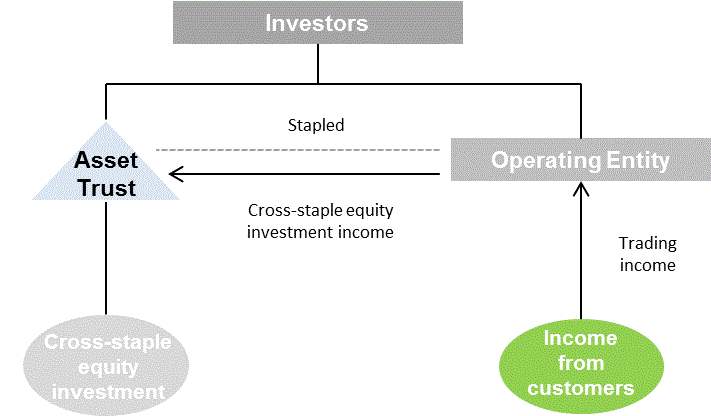
We are concerned:
- •
- payments made under the cross-staple synthetic equity investment would not be deductible to Operating Entity under section 8-1 and/or Division 230 of the ITAA 1997
- •
- Asset Trust may control, or be able to control, Operating Entity for the purposes of Division 6C of Part III of the ITAA 1936:
- An example of this would be where a cross-staple synthetic equity investment gives rights to Asset Trust that amounts to control. (If control does not arise under the investment, but Asset Trust has the primary economic exposure to the success and/or failure of Operating Entity's underlying business operations, it would be necessary to consider whether the absence of the control that would be naturally consistent with that exposure is for a tax purpose.)
- •
- where applicable, whether Asset Trust and the Investors satisfy the definition of a MIT and, consequently, the validity of any capital treatment choice under Subdivision 275-B of the ITAA 1997, and
- •
- where applicable, the cross-staple payment may be taxed as non-arm's length income under Subdivision 275-L of the ITAA 1997 on the basis the transactions entered into would not be ones that parties dealing with each other at arm's length in relation to the transactions would have entered into.
3. Royalty staple
A royalty staple typically displays all or most of the following features:
- •
- Division 6C of Part III of the ITAA 1936 does not apply to Asset Trust because the investors of Asset Trust are such that Asset Trust cannot be a 'public unit trust'
- •
- Asset Trust holds assets such as intellectual property, mining tenements, industrial equipment, or other assets of a business that are purportedly capable of producing a royalty
- •
- Operating Entity pays a royalty or a purported royalty to Asset Trust
- •
- Operating Entity claims a tax deduction for the payments made to Asset Trust, and
- •
- the distributions from Asset Trust to non-resident investors are purportedly subject to royalty withholding tax (usually at a rate capped under a Treaty).
A royalty staple may arise when either:
- •
- a new business commences to be operated through this structure
- •
- an existing single business is restructured into this structure, without a change of ownership, and
- •
- the selected assets and business operations are acquired from a third party and held in this structure.
The diagram below shows a simplified example of a royalty staple.
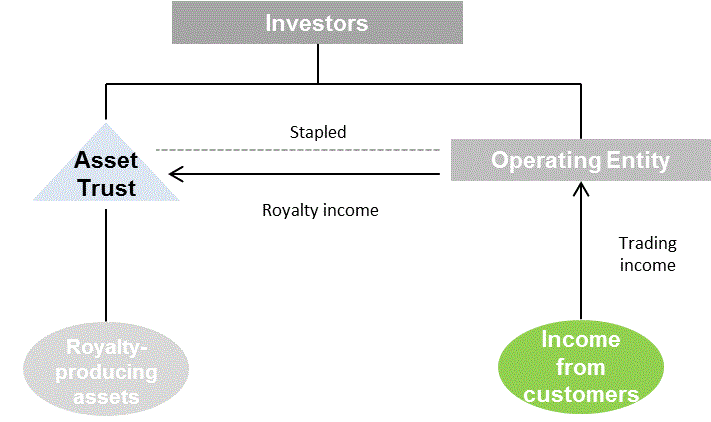
We are concerned:
- •
- the assets owned by Asset Trust may not be of a type in relation to which a royalty may be derived, and
- •
- even if the assets are of that type, the income Asset Trust derives may not be a royalty for the purposes of subsection 6(1) of the ITAA 1936.
4. Rental staple
A rental staple typically displays all or most of the following features:
- •
- Asset Trust owns selected assets, being assets which are usually purportedly land or a fixture on land
- •
- Operating Entity enters into one or more agreements with Asset Trust to lease or otherwise access the selected assets to enable Operating Entity to operate its business
- •
- the nature of the business is such that the transactions to divide the business in this manner are not transactions that third parties acting at arm's length would usually enter into, and it is often also the case that the business is not one capable of division in any commercially meaningful way
- •
- Operating Entity claims a tax deduction for the payments made to Asset Trust under the agreement(s), and
- •
- Asset Trust and Investors may also purportedly be a MIT under section 275-10 of the ITAA 1997.
A rental staple may arise when either:
- •
- a new business commences to be operated through this structure
- •
- an existing single business is restructured into this structure, without a change of ownership, and
- •
- the selected assets and business operations are acquired from a third party into this structure.
The diagram below shows a simplified example of a rental staple.
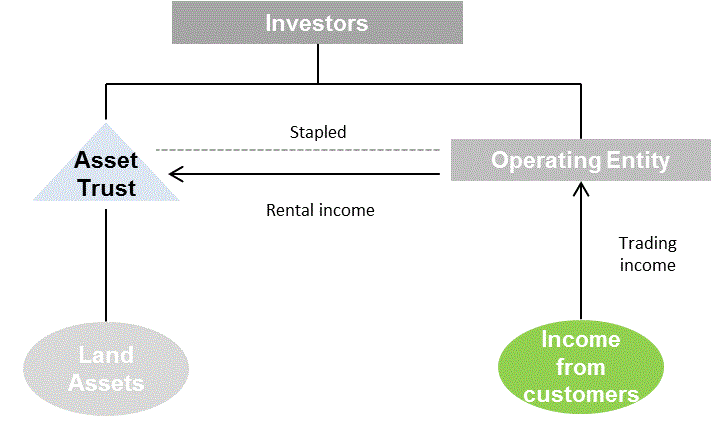
The diagram below shows a simplified example of the creation of a rental staple by restructure of an existing business.
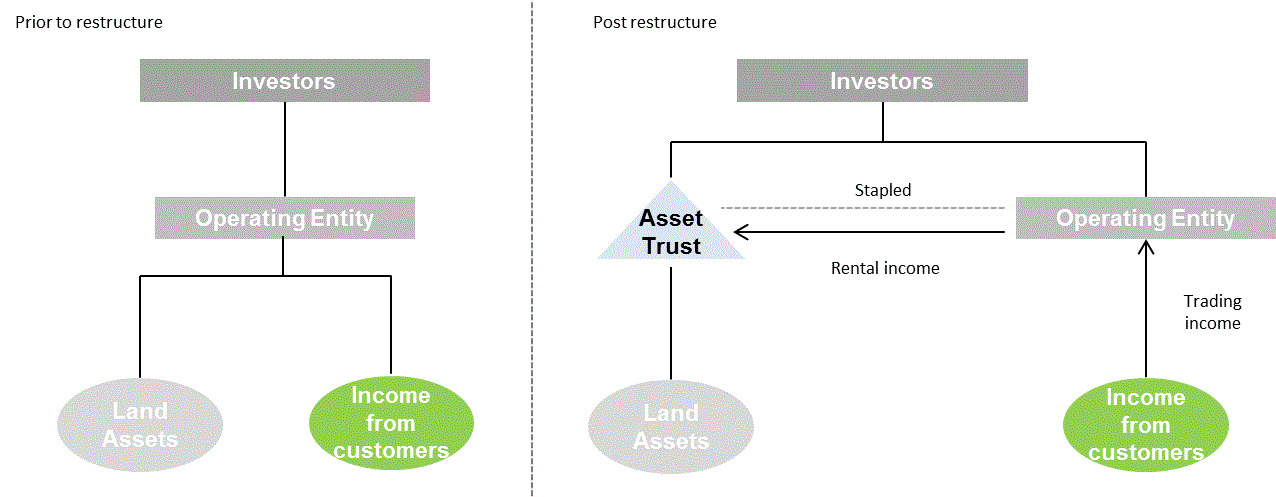
The stapled structures law applies where an Asset Trust and Operating Entity have sufficient common ownership (broadly 80%), such that there is a 'cross staple arrangement'. Payments made which are attributable to the arrangement, and which are amounts in the assessable income of a MIT (this is specified as MIT cross staple arrangement income, a class of non-concessional MIT income ( NCMI )), will be subject to withholding from fund payments at a higher rate.
Hence, a MIT will no longer have access to the concessional MIT withholding rate on the basis that it is NCMI. The MIT withholding rate on fund payments attributable to NCMI will be increased to 30%.
The stapled structures law will not, however, apply where the income of the Asset Trust is not distributed through MITs or where Asset Trust and Operating Entity do not have 80% common ownership. In these cases, this Alert will continue to apply.
Where the Alert continues to apply in respect of rental staples, we are concerned:
- •
- for the purposes of Division 6C of Part III of the ITAA 1936:
- •
- Asset Trust may control, or be able to control, Operating Entity (see examples above)
- -
- the assets of Asset Trust may not constitute 'land' in the circumstances
- -
- the income Asset Trust derives may more appropriately be characterised as trading business income than rent income, and
- -
- Asset Trust may not be investing in land for the required 'purpose' where the overall structure is one which re-characterises trading business income.
- •
- where applicable, whether Asset Trust and the Investors satisfy the definition of a MIT and, consequently, the validity of any capital treatment choice under Subdivision 275-B of the ITAA 1997, and
- •
- where applicable, the cross-staple payment may be taxed as non-arm's length income under Subdivision 275-L of the ITAA 1997 on the basis the transactions entered into would not be ones that parties dealing with each other at arm's length in relation to the transactions would have entered into.
As outlined in the introduction to the Alert, there will be some 'third party use of building' businesses where our concern will focus on the arrangements between entities within the stapled structure (such as ensuring Operating Entity retains a sufficient share of the profits), rather than the stapled structure itself.
What are we doing?
We are engaging more closely with taxpayers who have proposed these arrangements to explore the issues of concern and ensure that arrangements of the type outlined above do not seek to avoid the payment of corporate tax. Taxpayers and advisors who implement these types of arrangements will be subject to increased scrutiny.
We are continuing to develop our technical position on these arrangements and expect to issue further guidance in respect of our concerns.
We are also seeking to develop public guidance for particular industries of the type described under rental staples, where the focus will be on cross staple transactions rather than the stapled structure itself.
What should you do?
We discourage taxpayers from entering into arrangements of these types.
If you are planning to enter or have entered into arrangements of these types we recommend you seek independent professional advice, review your arrangements and discuss your situation with us by emailing PGIAdvice@ato.gov.au
Amendment History
| Date of amendment | Part | Comment |
|---|---|---|
| 5 February 2020 | Transactions/structures which this Alert does not apply | Updated due to Treasury Laws Amendment (Making Sure Foreign Investors Pay Their Fair Share of Tax in Australia and Other Measures) Act 2019. This legislation now addresses the mischief associated with (certain) rental staples as described in this Alert. |
| Rental staple | Updated to expressly carve out those rental staples that are caught under the new law. |
Date of Issue: 31 January 2017
Date of Effect:
Legislative References:
Income Tax Assessment Act 1936
6(1)
Div 6 of Part III
Div 6C of Part III
Part IVA
Income Tax Assessment Act 1997
8-1
26-26
Div 230
Div 275
Subdiv 275-B
Subdiv 275-L
275-10
Div 974
974-70
974-80
Jeremy Hirschhorn
Deputy Commissioner Business Line: Public Groups and International
| Contact officer: | Rebecca McGirr |
| Business Line: | Public Groups and International |
| Phone: | (02) 9374 2083 |
| Date: | Version: | |
| 31 January 2017 | Original alert | |
| You are here | 5 February 2020 | Updated alert |
